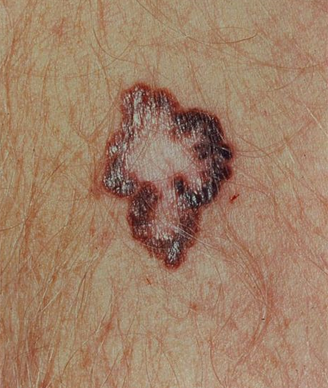ONS 2014: Updates in Melanoma
New treatment options for melanoma continue to be developed, especially in the areas of immunotherapies and targeted agents. Oncology nurses need to be knowledgeable about the various therapies being used, indication for use, and the management of adverse events.
Asymmetrical melanoma showing different colors.

With the incidence of melanoma on the rise compared with other cancers, the various treatment options available are becoming increasingly more important. Fortunately, treatment options for melanoma continue to develop, especially in the areas of immune and molecular targeted therapies.
This topic was presented at a session, “Updates in Melanoma: Immune-Modulating Agents and Molecular-Targeted Therapies,” by Brianna Hoffner, MSN, RN, ANP-BC, AOCNP, and Matthew Burke, MBA, RN, MSN, APRN-BC, at the 2014 Oncology Nursing Society (ONS) Annual Congress.
With therapies rapidly evolving, oncology nurses need to be knowledgeable about the various therapies being used, indication for use, and the management of adverse events.
Melanoma can present in cutaneous, mucosal, and ocular forms. When it comes to treatment, diagnostic workup and staging need to be considered. Surgery remains an important aspect in treating melanoma, as does chemotherapy, biotherapy (interleukin-2), immune modulating agents, and molecular targeted therapies.
Immune modulating agents, such as ipilimumab, an anti-cytotoxic T-lymphocyte antigen-4 (CTLA-4) therapy, are monoclonal antibodies that block the activation of immune cells. CTLA-4 is found on the surface of T cells, and cancers use this switch to turn off the body’s anti-cancer immune responses. The anti-tumor effects mediated by the CTLA-4 blockade have been attributed to sustained active immune responses against cancer cells. The 5-year data have shown significant superiority over chemotherapy for patients with locally advanced or unresectable stage III melanoma, as well as stage IV metastatic melanoma. The most common side effects that patients may experience are dermatitis, diarrhea/colitis, hepatitis, and endocrinopathies such as hypopituitarism. Depending on the severity, many of these side effects can be managed with steroids, proper diet, and other supportive medications, but they may also require doses being delayed or stopped altogether.
Another type of immunotherapy that is showing promise is anti–programmed cell death (PD)-1 therapy. PD-1 is a T-cell coinhibitory receptor with a structure similar to CTLA-4. Agents still in trial that are directed against PD-1 are nivolumab, MK-3475, and MPDL3280A. Phase I studies are showing response rates of nearly 50%, including for patients who did not respond to ipilimumab. The side effects are similar to those for ipilimumab.
Other biotherapy drugs that are making their mark in melanoma are molecular targeted therapies. BRAF inhibitor drugs are indicated for those patients found to have a BRAF mutation, which is found in approximately 50% of melanoma cases. (BRAF testing should be performed in all melanoma patients.) Two US Food and Drug Administration (FDA)-approved drugs currently on the market, vemurafenib (Zelboraf) and dabrafenib (Tafinlar), have shown immediate tumor reduction, but with limited duration of efficacy. Some commonly treated side effects are dermatologic in nature, along with ocular, cardiac, and hepatic issues, as well as generalized side effects (joint pain, nausea, fatigue).
MEK inhibitors are another type of molecular targeted therapy that inhibit the mitogen-activated protein kinase enzymes MEK1/2. Trametinib (Mekinist) is the only FDA-approved MEK inhibitor used for patients with advanced melanoma whose tumors have BRAF mutations. MEK inhibitors can be used in combination with BRAF therapies to prolong response and decrease side effects.
Lastly, c-KIT is a type of receptor tyrosine kinase and a type of tumor marker that may be found in higher amounts with certain types of cancer, such as melanoma. Data suggest that mucosal or acral lentiginous melanomas with activating mutations or amplifications in c-KIT may be sensitive to a variety of c-KIT inhibitors. Currently, there are clinical trials taking place that utilize the drug imatinib mesylate for those patients with melanoma harboring the c-KIT mutation.
Some of these therapies are currently being used as a single agent, in combination with one another, or with radiation, as an FDA-approved treatment option or in clinical trials. These kinds of drug therapies will continue to emerge, so it’s important that oncology nurses be knowledgeable on the proper management of these patients.
Newsletter
Stay up to date on recent advances in the multidisciplinary approach to cancer.
Administering CAR T-Cell Therapy and Bispecific Agents in Nursing Practice
Registered nurses discuss research related to agents like ciltacabtagene autoleucel presented at the 2024 Oncology Nursing Society Congress.